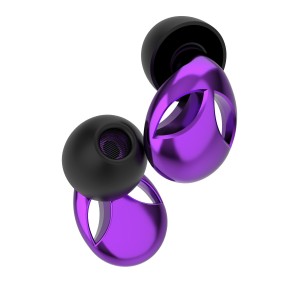

In today’s fast-paced and often noisy work environments, maintaining focus can be a challenge. Whether in open-plan offices, crowded co-working spaces, or even at home, the constant barrage of distractions can hinder productivity and reduce overall efficiency. This is where noise-canceling earplugs come in. These small yet powerful tools are becoming increasingly popular among professionals who seek to enhance their concentration and work output.
The Growing Need for Focus in the Workplace
The modern workplace is designed to be collaborative, but it often comes at the cost of personal focus. Open offices, in particular, are notorious for high noise levels — from conversations and phone calls to background chatter and the sounds of keyboards clicking. Research has shown that these distractions can significantly impair cognitive function, leading to reduced work performance, heightened stress levels, and even burnout.
In fact, a study conducted by the American Institute of Stress found that noise is one of the most common environmental stressors. For many employees, noise pollution can result in fatigue, irritability, and difficulty concentrating. This is where noise-canceling earplugs offer a simple yet effective solution.
How Noise-Canceling Earplugs Work
Noise-canceling earplugs work by using a combination of passive and active noise reduction techniques. Passive noise isolation is achieved through the physical structure of the earplugs, which block out a significant portion of ambient sound by creating a seal in the ear canal. This is particularly useful in filtering out constant, low-frequency sounds, such as the hum of air conditioning units or the murmur of background conversations.
Active noise cancellation (ANC), on the other hand, uses built-in microphones to detect incoming sound waves and generates an opposite sound wave to cancel out the noise. This technology is especially effective at eliminating higher-frequency, more irregular noises, such as sudden conversations, typing, or even the sounds of machinery in a factory setting.
By combining these two mechanisms, noise-canceling earplugs can help individuals block out distracting noises and create a more serene working environment, thereby fostering improved focus and productivity.
Benefits of Using Noise-Canceling Earplugs at Work
Increased Focus and Concentration: One of the most obvious benefits of noise-canceling earplugs is their ability to enhance concentration. By reducing distractions, employees can better immerse themselves in tasks that require deep cognitive engagement, such as writing reports, analyzing data, or strategizing for a meeting.
Improved Mental Well-being: Constant noise can lead to stress and mental fatigue. Noise-canceling earplugs create a calmer atmosphere, which can help alleviate anxiety, reduce stress levels, and improve overall mental well-being.
Better Quality of Sleep: For those who work from home or in shared spaces, noise-canceling earplugs can also be useful in ensuring that sleep is not disturbed by external sounds. Adequate rest is crucial for maintaining focus and energy levels throughout the workday.
Enhanced Communication: Ironically, while noise-canceling earplugs help in reducing distractions, they can also improve communication. In noisy office environments, having the ability to focus and tune out background noise can make it easier to follow conversations, participate in meetings, and collaborate effectively.
Health Benefits: Chronic exposure to high noise levels can contribute to hearing loss and other health problems. Noise-canceling earplugs provide a protective barrier for the ears, helping to reduce the risk of long-term hearing damage.
Types of Noise-Canceling Earplugs for Work
There are several types of noise-canceling earplugs available on the market, catering to different needs and preferences.
Foam Earplugs: These are the most basic and affordable option. They provide excellent passive noise reduction by expanding to fit the ear canal and blocking out a wide range of sounds. While they do not feature active noise cancellation, they are effective for general noise isolation.
Electronic Noise-Canceling Earplugs: These earplugs are equipped with active noise cancellation technology, making them ideal for those who need a high level of sound suppression. They are especially beneficial in very noisy environments, such as open offices or manufacturing floors.
Custom-Fit Earplugs: For people who need long-term comfort, custom-fit earplugs are a great option. These earplugs are molded to fit the unique shape of the user’s ears, providing superior comfort and enhanced noise isolation.
Bluetooth-enabled Earplugs: Some noise-canceling earplugs also come with Bluetooth connectivity, allowing users to listen to music or take calls while blocking out ambient noise. These are perfect for remote workers or those who prefer to listen to ambient music while working.
Challenges and Considerations
While noise-canceling earplugs offer many benefits, they are not without their challenges. For one, some individuals may find them uncomfortable, particularly if they are not custom-fit. Additionally, certain noise-canceling models can be bulky, making them less practical for all-day wear.
Another consideration is that complete isolation from workplace noise can sometimes lead to feelings of disconnection, especially in environments that value collaboration. It is important for users to find the right balance between reducing distractions and staying engaged with their team or colleagues.
Conclusion
In an era where distractions are constant and focus is a prized commodity, noise-canceling earplugs have emerged as a valuable tool for professionals looking to enhance their productivity and well-being. Whether used in a busy office, during virtual meetings, or while tackling demanding tasks, these earplugs can provide the quiet space needed to achieve better focus and improve overall work performance. As noise-canceling technology continues to evolve, it is likely that these tools will become an even more integral part of the modern workplace.



6 Comment(s)
FB88 luôn cung cấp các sản phẩm game chất lượng cao và dịch vụ khách hàng tốt.
FB88 có một hệ thống thanh toán rất nhanh chóng và an toàn.
Các game được cập nhật thường xuyên, tôi luôn có thể trải nghiệm nội dung mới nhất.
Trường Tiểu học Nguyễn Trung Trực được thành lập năm 1985 có địa chỉ tại 9A Phạm Hồng Thái, phường Nguyễn Trung Trực, quận Ba Đình, Hà Nội (Nay thành phường Trúc Bạch). Trường hoạt động dưới sự quản lý của UBND quận Ba Đình và Phòng Giáo dục và Đào tạo Ba Đình. Trường được xây dựng khang trang trên diện tích hơn 3000 m2 với đủ các phòng học và phòng chức năng cho các hoạt động học tập, vui chơi, giải trí của học sinh.
Địa chỉ: Số 9A Phạm Hồng Thái - Ba Đình - Hà Nội
Email: c1nguyentrungtruc-bd@hanoiedu.vn
website: https://c1nguyentrungtruc.badinh.edu.vn/
Điện thoại: 438261441
Trường Tiểu học Nguyễn Trung Trực được thành lập năm 1985 có địa chỉ tại 9A Phạm Hồng Thái, phường Nguyễn Trung Trực, quận Ba Đình, Hà Nội (Nay thành phường Trúc Bạch). Trường hoạt động dưới sự quản lý của UBND quận Ba Đình và Phòng Giáo dục và Đào tạo Ba Đình. Trường được xây dựng khang trang trên diện tích hơn 3000 m2 với đủ các phòng học và phòng chức năng cho các hoạt động học tập, vui chơi, giải trí của học sinh.
Địa chỉ: Số 9A Phạm Hồng Thái - Ba Đình - Hà Nội
Email: kumu.io@kumu.io
website: Https://kumu.io/NhacaiFB88betB88S/nhacaifb88betb88s#nhacaifb88betb88s
Điện thoại: 438261441
Trường Tiểu học Nguyễn Trung Trực được thành lập năm 1985 có địa chỉ tại 9A Phạm Hồng Thái, phường Nguyễn Trung Trực, quận Ba Đình, Hà Nội (Nay thành phường Trúc Bạch). Trường hoạt động dưới sự quản lý của UBND quận Ba Đình và Phòng Giáo dục và Đào tạo Ba Đình. Trường được xây dựng khang trang trên diện tích hơn 3000 m2 với đủ các phòng học và phòng chức năng cho các hoạt động học tập, vui chơi, giải trí của học sinh.
Địa chỉ: Số 9A Phạm Hồng Thái - Ba Đình - Hà Nội
Email: kumu.io@kumu.io
website: Https://kumu.io/NhacaiFB88betB88S/nhacaifb88betb88s#nhacaifb88betb88s
Điện thoại: 438261441
Trường Tiểu học Nguyễn Trung Trực được thành lập năm 1985 có địa chỉ tại 9A Phạm Hồng Thái, phường Nguyễn Trung Trực, quận Ba Đình, Hà Nội (Nay thành phường Trúc Bạch). Trường hoạt động dưới sự quản lý của UBND quận Ba Đình và Phòng Giáo dục và Đào tạo Ba Đình. Trường được xây dựng khang trang trên diện tích hơn 3000 m2 với đủ các phòng học và phòng chức năng cho các hoạt động học tập, vui chơi, giải trí của học sinh.
Địa chỉ: Số 9A Phạm Hồng Thái - Ba Đình - Hà Nội
Email: s666@s666s666s.com
website: Https://s666s666s.com/
Điện thoại: 438261441
Trường Tiểu học Nguyễn Trung Trực được thành lập năm 1985 có địa chỉ tại 9A Phạm Hồng Thái, phường Nguyễn Trung Trực, quận Ba Đình, Hà Nội (Nay thành phường Trúc Bạch). Trường hoạt động dưới sự quản lý của UBND quận Ba Đình và Phòng Giáo dục và Đào tạo Ba Đình. Trường được xây dựng khang trang trên diện tích hơn 3000 m2 với đủ các phòng học và phòng chức năng cho các hoạt động học tập, vui chơi, giải trí của học sinh.
Địa chỉ: Số 9A Phạm Hồng Thái - Ba Đình - Hà Nội
Email: s666@s666s666s.com
website: Https://s666s666s.com/
Điện thoại: 438261441
Leave a Comment